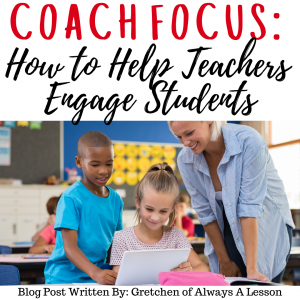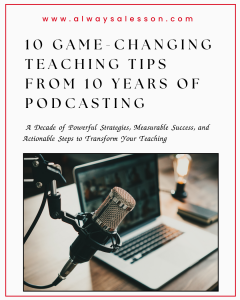Coach Focus: How to Help Teachers Engage Students
 Teacher leaders can help classroom teachers engage students in authentic, meaningful ways. As a matter of fact, student interaction is not the same as student engagement. A compliant class that interacts with each other and the content of the lesson translates to limited engagement and a low rate of learning. But, when teacher leaders provide the support and structure for teachers to develop authentic engagement strategies for their students, it translates to a high rate of learning.
Teacher leaders can help classroom teachers engage students in authentic, meaningful ways. As a matter of fact, student interaction is not the same as student engagement. A compliant class that interacts with each other and the content of the lesson translates to limited engagement and a low rate of learning. But, when teacher leaders provide the support and structure for teachers to develop authentic engagement strategies for their students, it translates to a high rate of learning.
This is the third post in the Coach Focus Series. (Catch up on the first and second posts.) Also, a recent post for teachers entitled, 3 Tips to Maximize Student Engagement, is a helpful read for teacher leaders to pass on to those that they support.
Student engagement is the third pillar in creating a classroom climate that promotes learning. When teachers first design lessons instead of planning them and second manage a classroom instead of student behavior, the foundation for true student engagement is created. This means it is essential that teachers leaders help teachers set up live and behind-the-scenes structures to operate within so that the opportunity for students to truly engage is available.
The same is true when it comes time to implement engagement strategies. Teacher leaders can help classroom teachers set up time, space and structure for students to move from interaction to engagement. It requires planning, intentionality and follow-through.
Planning for How to Engage Students
It is no longer enough to ask students to interact with each other. As educators, we have to provide the structure and support to encourage engagement. Instead of head nods, eye contact, or asking and answering questions, we have to help teachers create time and space for students to move beyond the superficial in the learning experience. When teachers take time to plan for specific ways for their students to contribute to their peers’ learning while also digging deep into their own processing, student achievement soars.
Teacher leaders can provide a professional development session or quick exercise during a planning period to note which actions they use regularly fit under the “interaction” or “engagement” category. This eye-opening experience helps teachers notice the missed opportunities to go deeper with students as they learn.
After an introductory activity deciphering interaction from engagement, teacher leaders can meet individually or in small groups with teachers to talk through their upcoming lessons using the lens of engagement. By turning up the dial in how students engage with each other and the content, it will translate to higher rates of learning. But teachers need the time to plan for them as well as a partner to talk through potential pitfalls and work through rolling out the new requirements to students.
This preparation ensures teachers better understand how to engage students while giving them the support to bring it to life in their classrooms.
Intentionality in How to Engage Students
Attention to detail is what separates good teachers from great ones. Teacher leaders can demonstrate intentionality when providing the initial professional development opportunity. This is a way to showcase how to think through a lesson from the mountain top down to the ground floor. By zooming in and out of a lesson, teachers have a better idea of how every engagement builds on top of the one before it, increasing in rigor and deepening in understanding.
No longer can we just place interactions back to back and hope it helps students decode their new knowledge.
[bctt tweet=”We have to intentionally create engagement opportunities, layering them in such a way that it supports students from the obvious to the inference.” username=”gschultek”]
Teacher leaders can provide examples and practice opportunities for classroom teachers as they learn how to sprinkle engagement throughout a lesson while stretching students’ thinking.
Follow-Through for How to Engage Students
Engagement is not just something a teacher plans and students do. It’s a three tier system: teacher offering, student engagement, teacher follow-through. The follow-through is essential in providing feedback to students, guiding their thinking out of dead ends or troubled spots, and praising students for going deeper and wider than ever before. The follow-through is what celebrates growth and motivates students to continue doing the challenging cognitive work.
Teacher leaders can provide sentence stems or prompts for teachers to use as they begin to follow- through on various engagement opportunities with students. As the new habit forms, teacher leaders can provide feedback to classroom teachers on other ways they can follow-through to build a varied tool kit of support for students.
As a reminder, student engagement is not the same as student interaction. Teachers need support from teacher leaders to implement these changes into their instruction. It is not an overnight change, as the way teachers plan and deliver lessons are very much ingrained in muscle memory. Teacher leaders can provide the latest knowledge, practice opportunities and personalized feedback to increase awareness and skillset in classroom teachers. Overtime, teachers will strengthen their muscle memory and develop new habits in designing, delivering and maintaining authentic engagement strategies in their lessons.
Resource Suggestions
- Help teachers plan for authentic engagement in the classroom (Grab those materials here).
- Provide the necessary support to guide teachers towards achieving their goals with student engagement (Grab those materials here).
- This freebie on “The Top 5 Ways to Drive Authentic Student Engagement in the Classroom” is helpful too in getting teachers to plan for what they desire in their classroom with engagement.
If you are need of resources to help you become an even stronger coach, browse these printable and digital options. Check out my instructional coaching must-haves here. Also, catch up on other help instructional coaching blog posts here.
How do you help teachers engage students?


